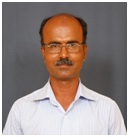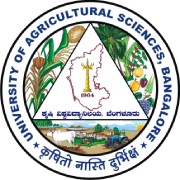
| AICRP Scheme/Unit : AICRP on Forage Crops and Utilization | |||||||||||||||||||||||||||||||||||||||||||||||||||||||||||||||||||||||||||||||||
| Location : Zonal Agricultural Research Station, V. C. Farm, Mandya | |||||||||||||||||||||||||||||||||||||||||||||||||||||||||||||||||||||||||||||||||
| Year of Start : 1987 (Initially at ARS Tiptur and later shifted to ZARS, Mandya in 2004) | |||||||||||||||||||||||||||||||||||||||||||||||||||||||||||||||||||||||||||||||||
| Mandates :
Ø Development of high yielding multiple stress tolerant varieties/hybrids with desired quality parameters. Ø Enrichment, evaluation, documentation and utilization of forage genetic resources Ø Forage production technologies for different Agro-ecological situation. Ø Intensive forage production through Silvi/Horti – pasture system. Ø Promotion of fodder trees (Sesbania, Glyricidia, Erithrinia, Subabul) based cropping system under rainfed and irrigated ecosystem. Ø Finding out scope of organic fodder production. Ø Bio-fortification and Nano-technology for enhancing forage yield and quality. Ø Development of appropriate forage production technologies for problematic soils. Ø Development of year round fodder production module for different Agro-ecological situation |
|||||||||||||||||||||||||||||||||||||||||||||||||||||||||||||||||||||||||||||||||
| Research Programmes :
v Development of forage production technologies including nutrient management, cropping system, water management, bio-fortification and Nano-technology v Development and release forage varieties v Preservation and storage i.e silage/hay making of fodder cowpea, maize, B x N Hybrid, Guinea grass, Pearl millet, Oats and lucerne |
|||||||||||||||||||||||||||||||||||||||||||||||||||||||||||||||||||||||||||||||||
| Research Accomplishments :
(Varieties released /Technologies developed / Patents developed/ Commercialized etc…)
a) Details of varieties released from Mandya centre in brief Crop: Fodder cowpea 1) MFC-08-14:This variety is derived from the cross KBC 2 ×BundelLobia 1 through Pedigree method and released at southern parts of the Country during 2014-15. Superior in green forage yield (200.43 q/ha) over best check UPC-9202 (182.27 q/ha). High seed yield (7.40 q/ha) compared to checks and possesses resistance to rust.
3) MFC-09-3:It is derived from the cross UPC 5286 x UPC 628 and selected through pedigree method, released and notified for Karnataka state in the year 2021. The variety superior in green forage (309.7q/ha), dry matter (83.2 q/ha) and crude protein yield (12.4 q/ha) and possess higher leaf stem ratio (0.78) and lesser seed test weight with reduced seed rate.
BNH-10: The variety was developed by cross between BAIF Bajra-1 x Napier Grass BRN-2 through hybridization followed by clonal selection at BAIF Development Research Foundation, Urulikanchan, Pune, (Maharastra) during 2012. The variety has been endorsed for cultivation in the Karnataka state during the year 2014-15. It is having green forage yield potential of (1431 q ha-1) over check Co-3 (1392 q ha-1)
Crop: Guinea grass JHGG-08-1: The variety was developed through clonal selection from Bundel collection at IGFRI, Jhansi, The variety has been endorsed for cultivation in the Karnataka state duringthe year 2014-15 and it recorded green forage yield (1007 q/ha) over check Riversdale (668 q/ha) and having tall growing, high tillering, showing very quick and fast regeneration ability after every cut Crop: fodder Oat RO-11-1:The Single cut oat variety developed through pure line selection from RO-19 at MPKV, Rahuri, Maharastra. This variety found superior in green forage (383.12 q ha-1), dry matter (87.3 q ha-1) and crude protein yield (7.0 q ha-1) with good leaf stem ratio (0.55) as compared to local check, OS-6 (0.43) along with broad and dark green leaves
b) Production technologies in brief 1. Intensive forage production through Silvi-pasture system under rainfed ecosystem Intercropping of Pearl millet + Horse gram (3:1) in Subabulrecorded higher green forage (411.0 q/ha) and dry matter yield (88.0 q ha-1). Net monetary returns (Rs. 22,009 ha-1) and B:C ratio (2.87). Whereas, higher crude protein yield was recorded with intercropping of Hedge lucerne in Subabul(14.20 q/ha)
2. Enhancing green forage yield of fodder sorghum in saline alkali soil Application of recommended NPK + FYM (10 t ha-1) + ZnSO4 20 kg ha-1+ Gypsum (100 % GR) recorded significantly higher green fodder (252.48 q ha-1), dry matter yield (68.02 q ha-1), crude protein yield (4.62 qha-1) and net monetary return (Rs. 8335 ha-1).The higher B:C ratio was obtained with recommended NPK + press mud (10 t ha-1) (1.60) in forage production in saline alkali soil
3. Fodder production in rice fallows under limited moisture situation
In rice fallows, maize + cowpea cropping system supplemented with 100% RDN produced significantly higher green forage (465.16 q ha-1) and dry matter yield (113.51 q ha-1). 4. Lean season fodder production under limited irrigation Fodder maize recorded significantly higher green forage yield (393.12 q ha-1), whereas pearl millet recorded maximum water use efficiency (14.69q ha-1 cm). Whereas maize harvested for baby corn recorded higher net monetary returns (Rs.46, 576 ha-1) and B:C ratio (3.65). 5. Standardization of planting geometry and nutrient levels for Bajra Napier Hybrid variety BNH-10 Planting geometry of 90cm × 60cm recorded significantly higher green forage yield (1495.7q/ha) over others. Application of 150% Recommended dose of fertilizers recorded higher green forage yield (1484.0 q/ha). Whereas, B:C ratio was higher with 100% recommended dose of fertilizers (3.17). Based on the results, spacing of 90 cm X 60 cm with 100% RDF (180: 120: 80 NPK Kg/ha) found optimum and economical.
6. Standardization of planting geometry and nutrient levels for guinea grass variety JHGG-08-1 Planting geometry of 60cm × 45cm recorded significantly higher green forage yield (1193.0 qha-1). Application of 150% recommended dose of fertilizer recorded higher green forage yield (1233.0 q/ha), which was on par with 100% RDF (1163.0 q/ha). Based on results, 60cm × 45cm with 100% RDF (200:50:25 NPK kg/ha) found optimum and economical.
7. Year round green fodder production module for irrigated condition B × N hybrid + Lucerne (2:8) recorded higher green fodder yield (1679.0 qha-1), dry matter yield (368.0 q/ha), crude protein yield (44.0 q/ha) and net monetary returns (Rs. 1, 54,475 ha-1) and B: C ratio (2.93) followed by B × N hybrid + Cowpea (2:8) recorded higher green forage (1492.0 q ha-1), dry matter yield (322.0 q/ha), crude protein yield (38.0 q/ha) and net monetary returns (Rs. 1,29,390 ha-1)
8. Agro techniques for Congo signal grass (Brachiariaruziensis) variety DBRS-1 Irrigated situation recorded higher green forage yield (481.55 q ha-1) as compared to Rainfed (282.69 q/ha). Planting geometry of 60 X 60 cm significantly recorded higher green forage yield (407.22 q ha-1) over 45 X45 cm (357.03 q ha-1). Application of Nitrogen 30 kg/ha after each cut recorded significantly higher green forage yield (371.72 q & 609.65 q ha-1under Rainfed& Irrigated situation respectively.Planting geometry of 60 X 60cm with N levels of 30 kg of ha / each cut numerically recorded higher GFY 408.89 q & 639.10 q/ha under Rainfed& Irrigated situation respectively 9. Agase (Sesbaniagrandiflora) based cropping system under protective irrigation Inter-cropping B x N Hybrid with Agase (2:1) recorded higher green forage (602.4 q ha-1), dry matter (88.3 q/ha) and crude protein yield (11.8 q/ha) and net monitory returns (Rs. 52,975 ha-1) and B: C ratio (2.23) followed by Inter-cropping of perennial fodder sorghum with Agase recorded higher green forage (591.2 q/ha), dry matter yield (107.2 qha-1), crude protein yield (13.1 qha-1) and net monetary returns (Rs.49,620 ha-1) and B: C ratio (2.14). 10. Production of fodder Maize and Cowpea through hydroponics Fodder Maize: Green forage yield from one kg of seed was highest at seed density of 300 g/sft (5.51 kg green forage yield per kg of seed) as compared to other densities. No significant differences were observed in green forage yield with different harvest intervals. However crop harvested on13th day was recorded higher green forage yield (5.40 kg/sft).
Green forageyield from one kg of seed was highest at seed density of 300 g/sft (7.64 Kg green forageyield per kg of seed) as compared to other densities.No significant differences were observed in green forageyield with different harvest intervals. However, crop harvested onv15th day was recorded higher GFY (7.26 kg/sft) as compared to other intervals.
11. Performance top feeds under varied planting geometry with and without intercrop Among top feeds Agase recorded higher green forage yield (589.8 q ha-1), dry matter yield (103.9 q ha-1) and crude protein yield (17.6 q ha-1) over Drumstick and Erythrina. The planting geometry of 2m × 0.5m recorded higher total green forage yield (543.0 q ha-1), dry matter yield (98.6 q ha-1) and crude protein yield (15.8 q ha-1). Intercropping of B × N hybrid recorded higher green forage yield (703.6 q ha-1) over sole crop of top feeds (274.7 q ha-1).Agase with planting geometry of 2m × 0.5m + intercrop of B × N hybrid recorded higher net monetary returns (Rs./2,40,432 ha-1) and B:C ratio of 4.3 |
|||||||||||||||||||||||||||||||||||||||||||||||||||||||||||||||||||||||||||||||||
| Awards / Recognitions:
|
|||||||||||||||||||||||||||||||||||||||||||||||||||||||||||||||||||||||||||||||||
| Facilities Available:
v Fodder quality analysis lab v Research facilities for conducting experiments v Geno types of different forage crops |
|||||||||||||||||||||||||||||||||||||||||||||||||||||||||||||||||||||||||||||||||
| Other Activities:
v Activities under Development Action Plan for Scheduled Caste (DAPSC) earlies Scheduled Caste Sub-Plan (SCSP) Progamme v Activities under Development Action Plan for Scheduled Tribal Component (DAPSTC) earlier Tribal Sub Plan (TSP) Progamme v Forage technology demonstration (FTDs) |
|||||||||||||||||||||||||||||||||||||||||||||||||||||||||||||||||||||||||||||||||
| Externally Funded Projects in Operation: | |||||||||||||||||||||||||||||||||||||||||||||||||||||||||||||||||||||||||||||||||
| No. | Project Title | Principal Investigator | Funding agency | Year of Start | Year of Completion | Significant Outcome | |||||||||||||||||||||||||||||||||||||||||||||||||||||||||||||||||||||||||||
| 1 | Accelerating green fodder production through establishment of model demonstration unit in southern Karnataka | Dr. P. Mahadevu | RKVY | 2019 | 2024 | Imparting knowledge on fodder cultivation | |||||||||||||||||||||||||||||||||||||||||||||||||||||||||||||||||||||||||||
Staff Profile :
Scientific staff :

Academic Qualification : Ph. D (Agronomy)
Area of Specialization : Nutrient and Weed Management
Date of joining duty at UAS, Bangalore : 08-03-1993
Date of Joining Scheme /Unit : 28-07-2005
bgshekar66@gmail.com
shekara_gundanaik@rediffmail.com
08232-244147

Academic Qualification : Ph. D (Genetics and Plant breeding)
Area of Specialization : Breeding of cereals and forage crops
Date of joining duty at UAS, Bangalore : 11-04-2007
Date of Joining Scheme /Unit : 29-05-2015
pmahadevu69@gmail.com
08232-244147
Technical staff :

Academic Qualification : Ph. D (Agricultural Entomology)
Area of Specialization : Insect pests of field crops, ear head caterpillars and Forage crops
Date of joining duty at UAS, Bangalore : 30-12-2013
Date of Joining Scheme/Unit : 30-12-2013
nmchikkarugi@uasbangalore.edu.in
chikka68@gmail.com
08232-244147
Supporting staff :

Academic Qualification : SSLC
Date of joining duty at UAS, Bangalore : 25-05-1994
Date of Joining Scheme/Unit : 20-04-2012

Academic Qualification : SSLC
Date of joining duty at UAS, Bangalore : 11-08-2003
Date of Joining Scheme/Unit : 03-07-2019
-
- Page Visitors Count:
- Last Updated: March 19, 2025
- Site Statistics





















